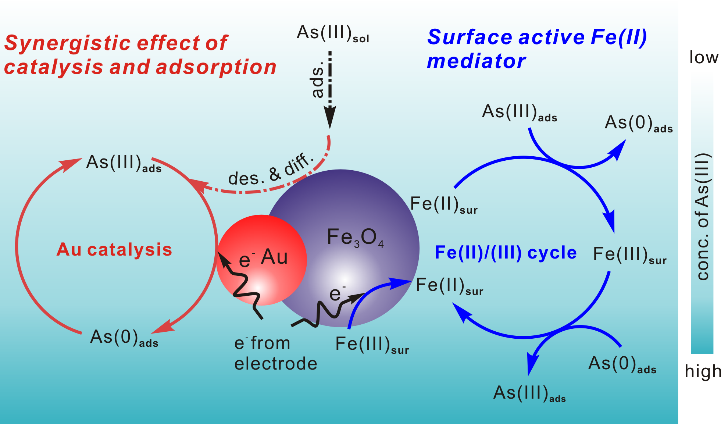Recently, collaborating with Prof. ZHANG Lizhi from Central China Normal University, Prof. HUANG Xingjiu in Institute of Intelligent Machines, Hefei Institutes of Physical Science, designed ultra-highly sensitive electrochemical sensing of arsenic(III) promoted by surface Fe(II)/Fe(III) cycle on dumbbell-like Au/Fe3O4 nanoparticles. Journal of Analytical Chemistry published their work.
Developing a new ultra-sensitive interface to detect As(III) is highly desirable because of its seriously toxic and low concentration in drinking water. Recently, Fe3O4 nanoparticles of high adsorption toward As(III) show its prospect to be such an interface, which, however, is still limited by the poor understanding of their surface physicochemical properties.
Aiming at this, researchers synthesized and applied sub-20 nm dumbbell-like Au/Fe3O4 nanoparticle for As(III) detection under nearly neutral conditions with square wave anodic stripping voltammetry (SWASV).
Through the study, they found the excellent performance of Au/Fe3O4 modified screen-printed carbon electrode (SPCE) for As(III) analysis by combining the catalytic properties of Au NPs with the adsorption ability of the ~10 nm Fe3O4 NPs, as well as the enhanced redox activity by Fe(II)/Fe(III) cycling on the surface of Au/Fe3O4 nanoparticle.
Furthermore, the X-ray photoelectron spectroscopy (XPS) evidence of As and Fe on Au/Fe3O4 NPs after electro-adsorption and stripping of 10 ppm As(III) strongly proved that the redox of As(0)/As(III) occurred directly on sub-20 nm Au/Fe3O4 NPs with the assistance of Fe(II)/(III) cycle.
Meanwhile, a more distorted local coordination of Fe–O and Fe–Fe in 10 nm Fe3O4 NPs, which has been proved by extended X-ray absorption fine structure (EXAFS), offers their higher adsorption and surface atom activity.
Combining the data of XPS with EXAFS and electrochemistry, this work reveals that the Fe(II)/Fe(III) cycle at ~ 10 nm Fe3O4 and Au/Fe3O4 NPs surface can highly enhance the electroanalysis performance toward As(III).
Most importantly, this work not only proposes a sensitive sensors but also is critical to provide novel insights and new theoretical and experimental investigations in understanding the mechanism of electroanalysis from the viewpoint of surface active atoms.
This work was supported financially by the National Natural Science Foundation of China (21735005, 21475133, U1532123, 61573334, 61474122 and U1532120), Natural Science Funds for Distinguished Young Scholars (Grant 21425728), and National Natural Science Fund of China (11405256). The authors thank Shanghai Synchrotron Radiation Facility (beam line BL14W1) for providing measurement time. X.-J.H. acknowledges the CAS Interdisciplinary Innovation Team and the CASHIPS Director’s Fund (YZJJ201701) for financial support.
Link to the paper: Surface Fe(II)/Fe(III) Cycle Promoted Ultra-Highly Sensitive Electrochemical Sensing of Arsenic(III) with Dumbbell-like Au/Fe3O4Nanoparticles

Ultra-highly sensitive electroanalysis of As(III) based on the adsorption of ~10 nm Fe3O4 NPs and the catalyst of ~ 7 nm Au NPs as well as the redox mediation by surface-active Fe(II) at Au/Fe3O4 SPCE (Imaged by LI Shanshan).
Contact:
ZHOU Shu
Hefei Institutes of Physical Science (http://english.hf.cas.cn/)
Email: zhous@hfcas.ac.cn
 Tel: +86-551-65591206
Tel: +86-551-65591206
 Fax: +86-551-65591270
Fax: +86-551-65591270
 Emai: zhous@hfcas.ac.cn
Emai: zhous@hfcas.ac.cn
 350 Shushanhu Road
350 Shushanhu Road